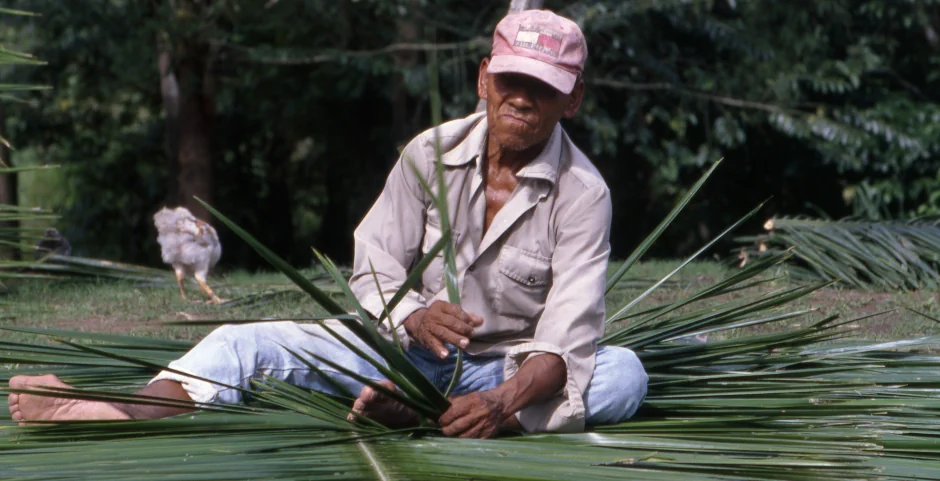The Indigenous Cocama People
Ethnonyms: Cocoma, Cocoma-Cocamilla, Huallaga, Kokama, Pampadeque, Pandequebo, Ucayali, Xibitaoan Countries inhabited: Brazil, Colombia, Peru Language family: Equatorial-Tucanoan Language branch: Tupi-Guarani
Tanauka translates literally into English as "house for everyone." Its contemporary, vernacular translation is "community center." That there is a single word for it in their language tells us something of the sense of community that exists in Cocama culture.
The indigenous Cocama people live mainly in the upper Amazon region of Peru, where they number around eighteen thousand, with just a few hundred more living in Brazil and Colombia. Their area of the Peruvian Amazon is sparsely inhabited and not easily reached: Iquitos is the largest place on Earth that cannot be reached by road and is a day or so away by commercial passenger boat.
Even then, a ride of a few more hours by small, out-board motor canoe is necessary to reach the closest Cocama community.
Despite this remoteness, the visitor experiences many influences from the outside world alongside an ancient lifestyle. Many Cocama communities now stay in touch with each other — and with the rest of the world — by short-wave radio.
At the same time, their houses are thatched with hand-woven jungle plants.
While some essential supplies are brought in by the large, commercial passenger boats that sail the big rivers, Cocama communities are largely self-sufficient in their agriculture and livestock provision. Each community is purposely situated by a large river, and so fish is a large part of their diet.
Probably the most striking change for the Cocama in their recent history is their rapid acculturation of the Spanish language. Although the Spanish came to these parts over 400 years ago, it is only the current and previous generation of Cocama that speak it as their first language. Historically, this transition has taken place due to government education policies that were influenced by a colonialist mindset.
More recently organizations like the Intercultural Bilingual Education Teacher Training Program (FORMABIAP) have begun to redress the balance between Western and local input to school curricula. An example of their success is the trend toward teaching Cocama as a second language in many Cocama schools.
With the beginning of education comes the beginning of self determination. Part of a fifth-grader's education includes a lesson on 'what is democracy?' She is instructed by her teachers to register and vote, taking advantage of the timing afforded by the upcoming, real national election.
Although it is only practice, she will hopefully carry the lesson into her adult years when she can vote for real. She may become a politician or she may become a seamstress: but it will be her education that allows her to choose for herself.
She will not become a shaman. Shamanism is reserved among the Cocama, like it is among all indigenous groups in this part of the world, for the chosen few. The schooling required to become a shaman is not influenced by the outside world. Indeed, it is unchanged from pre-colonial times. Her younger peer was chosen to learn the secrets of shamanism by her mother and father — both shamans themselves.
While the rest of their community worships in a church and prefers modern pharmaceuticals, Cocama shamans practice Animism and seek natural cures from the surrounding jungle.
Shamanism is not the only Cocama tradition to thrive and get passed on to the next generation. Besides the roof thatching noted earlier, Cocama villages are filled with examples of everyday-use items being made from the surrounding resources.
Above, we see an elder making rope from jungle resources and, below, a canoe being made by a young man. Weaving, baking and making jewelry are also commonly observed.
To some extent, geographic isolation has allowed the Cocama to preserve their culture to the present day. And to some extent it is the political system in which they have not been able to participate that is beginning to take their culture away from them.
Cocama children are now the ones who hold the future of their people in their hands. Education will be the key to the choices they can make. With education they could guide their people to the self-determination of that future; without it they will be powerless to resist the changes that will continue to be brought upon them by the modern world.
Photography copyright © 1999 - 2025, Ray Waddington. All rights reserved. Text copyright © 1999 - 2025, The Peoples of the World Foundation. All rights reserved.

Waddington, R. (2007, revised edition 2024), The Indigenous Cocama People. The Peoples of the World Foundation. Retrieved December 18, 2025, from The Peoples of the World Foundation. <https://www.peoplesoftheworld.org/text?people=Cocama>














